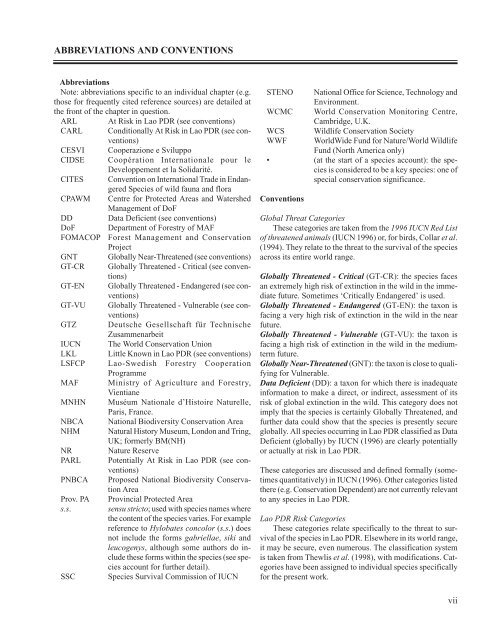Wildlife of Lao PDR: 1999 Status Report - IUCN
Wildlife of Lao PDR: 1999 Status Report - IUCN
Wildlife of Lao PDR: 1999 Status Report - IUCN
Create successful ePaper yourself
Turn your PDF publications into a flip-book with our unique Google optimized e-Paper software.
ABBREVIATIONS AND CONVENTIONS<br />
Abbreviations<br />
Note: abbreviations specific to an individual chapter (e.g.<br />
those for frequently cited reference sources) are detailed at<br />
the front <strong>of</strong> the chapter in question.<br />
ARL At Risk in <strong>Lao</strong> <strong>PDR</strong> (see conventions)<br />
CARL Conditionally At Risk in <strong>Lao</strong> <strong>PDR</strong> (see conventions)<br />
CESVI Cooperazione e Sviluppo<br />
CIDSE Coopération Internationale pour le<br />
Developpement et la Solidarité.<br />
CITES Convention on International Trade in Endangered<br />
Species <strong>of</strong> wild fauna and flora<br />
CPAWM Centre for Protected Areas and Watershed<br />
Management <strong>of</strong> DoF<br />
DD Data Deficient (see conventions)<br />
DoF Department <strong>of</strong> Forestry <strong>of</strong> MAF<br />
FOMACOP Forest Management and Conservation<br />
Project<br />
GNT Globally Near-Threatened (see conventions)<br />
GT-CR Globally Threatened - Critical (see conventions)<br />
GT-EN Globally Threatened - Endangered (see conventions)<br />
GT-VU Globally Threatened - Vulnerable (see conventions)<br />
GTZ Deutsche Gesellschaft für Technische<br />
Zusammenarbeit<br />
<strong>IUCN</strong> The World Conservation Union<br />
LKL Little Known in <strong>Lao</strong> <strong>PDR</strong> (see conventions)<br />
LSFCP <strong>Lao</strong>-Swedish Forestry Cooperation<br />
Programme<br />
MAF Ministry <strong>of</strong> Agriculture and Forestry,<br />
Vientiane<br />
MNHN Muséum Nationale d’Histoire Naturelle,<br />
Paris, France.<br />
NBCA National Biodiversity Conservation Area<br />
NHM Natural History Museum, London and Tring,<br />
UK; formerly BM(NH)<br />
NR Nature Reserve<br />
PARL Potentially At Risk in <strong>Lao</strong> <strong>PDR</strong> (see conventions)<br />
PNBCA Proposed National Biodiversity Conservation<br />
Area<br />
Prov. PA Provincial Protected Area<br />
s.s. sensu stricto; used with species names where<br />
the content <strong>of</strong> the species varies. For example<br />
reference to Hylobates concolor (s.s.) does<br />
not include the forms gabriellae, siki and<br />
leucogenys, although some authors do include<br />
these forms within the species (see species<br />
account for further detail).<br />
SSC Species Survival Commission <strong>of</strong> <strong>IUCN</strong><br />
STENO National Office for Science, Technology and<br />
Environment.<br />
WCMC World Conservation Monitoring Centre,<br />
Cambridge, U.K.<br />
WCS <strong>Wildlife</strong> Conservation Society<br />
WWF WorldWide Fund for Nature/World <strong>Wildlife</strong><br />
Fund (North America only)<br />
• (at the start <strong>of</strong> a species account): the species<br />
is considered to be a key species: one <strong>of</strong><br />
special conservation significance.<br />
Conventions<br />
Global Threat Categories<br />
These categories are taken from the 1996 <strong>IUCN</strong> Red List<br />
<strong>of</strong> threatened animals (<strong>IUCN</strong> 1996) or, for birds, Collar et al.<br />
(1994). They relate to the threat to the survival <strong>of</strong> the species<br />
across its entire world range.<br />
Globally Threatened - Critical (GT-CR): the species faces<br />
an extremely high risk <strong>of</strong> extinction in the wild in the immediate<br />
future. Sometimes ‘Critically Endangered’ is used.<br />
Globally Threatened - Endangered (GT-EN): the taxon is<br />
facing a very high risk <strong>of</strong> extinction in the wild in the near<br />
future.<br />
Globally Threatened - Vulnerable (GT-VU): the taxon is<br />
facing a high risk <strong>of</strong> extinction in the wild in the mediumterm<br />
future.<br />
Globally Near-Threatened (GNT): the taxon is close to qualifying<br />
for Vulnerable.<br />
Data Deficient (DD): a taxon for which there is inadequate<br />
information to make a direct, or indirect, assessment <strong>of</strong> its<br />
risk <strong>of</strong> global extinction in the wild. This category does not<br />
imply that the species is certainly Globally Threatened, and<br />
further data could show that the species is presently secure<br />
globally. All species occurring in <strong>Lao</strong> <strong>PDR</strong> classified as Data<br />
Deficient (globally) by <strong>IUCN</strong> (1996) are clearly potentially<br />
or actually at risk in <strong>Lao</strong> <strong>PDR</strong>.<br />
These categories are discussed and defined formally (sometimes<br />
quantitatively) in <strong>IUCN</strong> (1996). Other categories listed<br />
there (e.g. Conservation Dependent) are not currently relevant<br />
to any species in <strong>Lao</strong> <strong>PDR</strong>.<br />
<strong>Lao</strong> <strong>PDR</strong> Risk Categories<br />
These categories relate specifically to the threat to survival<br />
<strong>of</strong> the species in <strong>Lao</strong> <strong>PDR</strong>. Elsewhere in its world range,<br />
it may be secure, even numerous. The classification system<br />
is taken from Thewlis et al. (1998), with modifications. Categories<br />
have been assigned to individual species specifically<br />
for the present work.<br />
vii

















